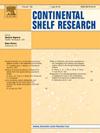整个美国西海岸大陆架浮标网络探测到的海洋热浪
IF 2.2
3区 地球科学
Q2 OCEANOGRAPHY
引用次数: 0
摘要
海洋热浪(MHWs)是指长时间异常温暖的海水,对全球海洋生态系统构成越来越大的威胁。虽然基于卫星的数据提供了对MHW模式的见解,但沿海上升流区域容易受到卫星偏差的影响,需要长期的原位数据集才能准确表征。利用分布在美国西海岸大陆架(离岸10-50公里)近2000公里海岸线上的22个表面浮标20年来的温度数据,我们首次调查了这一宝贵地区的mhw沿海分布模式。在2014-2016年的北太平洋MHW期间,MHW的空间范围从100%的浮标到区域事件期间的不到50%,再到单个浮标,突出了MHW尺度和驱动因素的广泛范围。无论是在春夏季上升流较少的季节时间尺度上,还是在天气时间尺度上,上升流的开始和结束分别与异常的弱和强上升流相关,上升流都是强流模式的重要贡献者。这在加利福尼亚中部和北部尤其明显,那里的上升流强度和变异性更强,区域共现率更低,而在加利福尼亚南部和俄勒冈州/华盛顿州,上升流更弱,区域共现率更高。此外,沿海地区的MHW指标几乎没有长期趋势,这表明该地区可能成为变暖海洋中的热避难所。有效管理和预测该地区沿海强飓风需要获取广泛的空间尺度和驱动因素,在许多情况下,具体地点的研究和/或高分辨率模型非常重要。本文章由计算机程序翻译,如有差异,请以英文原文为准。
Marine heatwaves detected by a network of buoys along the entire US West Coast Shelf
Marine heatwaves (MHWs), prolonged periods of anomalously warm waters, pose an increasing threat to marine ecosystems globally. While satellite-based data offer insights into MHW patterns, coastal upwelling regions are prone to satellite biases and require long-term in-situ datasets for accurate characterization. Using two decades of temperature data from 22 surface buoys distributed along the US West Coast continental shelf (10–50 km offshore) spanning nearly 2000 km of coastline, we investigated, for the first time, coast-wide patterns of MHWs in this valuable region. The spatial extent of MHWs varied from 100% of buoys during the 2014–2016 North Pacific MHW, to less than 50% during regional events, to single buoys, highlighting the broad range of MHW scales and drivers. Upwelling was a strong contributor to MHW patterns, both on seasonal time scales with less MHWs during the spring/summer upwelling season, as well as synoptic time scales with the initiation and termination of MHWs linked with anomalously weak and strong upwelling, respectively. This was especially evident in central and northern California, where upwelling intensity and variability were stronger and regional co-occurrence lower, than in southern California and Oregon/Washington, where upwelling was weaker and regional co-occurrence higher. Furthermore, there were almost no long-term trends in MHW metrics along the coast, suggesting this region could serve as a thermal refugia in a warming ocean. Effective management and forecasting of coastal MHWs in this region will require capturing a broad range of spatial scales and drivers, with site-specific studies and/or high-resolution models important in many cases.
求助全文
通过发布文献求助,成功后即可免费获取论文全文。
去求助
来源期刊

Continental Shelf Research
地学-海洋学
CiteScore
4.30
自引率
4.30%
发文量
136
审稿时长
6.1 months
期刊介绍:
Continental Shelf Research publishes articles dealing with the biological, chemical, geological and physical oceanography of the shallow marine environment, from coastal and estuarine waters out to the shelf break. The continental shelf is a critical environment within the land-ocean continuum, and many processes, functions and problems in the continental shelf are driven by terrestrial inputs transported through the rivers and estuaries to the coastal and continental shelf areas. Manuscripts that deal with these topics must make a clear link to the continental shelf. Examples of research areas include:
Physical sedimentology and geomorphology
Geochemistry of the coastal ocean (inorganic and organic)
Marine environment and anthropogenic effects
Interaction of physical dynamics with natural and manmade shoreline features
Benthic, phytoplankton and zooplankton ecology
Coastal water and sediment quality, and ecosystem health
Benthic-pelagic coupling (physical and biogeochemical)
Interactions between physical dynamics (waves, currents, mixing, etc.) and biogeochemical cycles
Estuarine, coastal and shelf sea modelling and process studies.
 求助内容:
求助内容: 应助结果提醒方式:
应助结果提醒方式:


